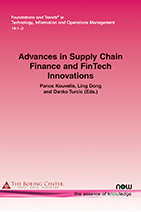Inventory and Financial Strategies with Capital Constraints and Limited Joint Liability
By Bin Cao, School of Business Administration, South China University of Technology, China, bmbinc@scut.edu.cn | Xin Chen, Department of Industrial Enterprise and Systems Engineering, University of Illinois at Urbana-Champaign, USA, xinchen@illinois.edu | T. C. Edwin Cheng, Department of Logistics and Maritime Studies, The Hong Kong Polytechnic University, Hong Kong, edwin.cheng@polyu.edu.hk | Yuan-Guang Zhong, School of Business Administration, South China University of Technology, China, bmygzhong@scut.edu.cn | Yong-Wu Zhou, School of Business Administration, South China University of Technology, China, zyw_666@hotmail.com
Abstract
We study the financial and operational decisions of two capital-constrained firms via a limited joint liability (LJL) financing scheme offered by a bank. We construct a two-stage game model in which the firms separately determine their individual ordering decisions according to the prior joint liability agreement between the firms and the bank. Applying non-cooperative game theory to analyze the decision-making problems of the two firms, we establish the existence of equilibrium decisions for the two firms. We derive mild conditions under which the LJL financing scheme is simultaneously preferred by the two firms. We show that the two firms’ strategies are complementary and the firms’ equilibrium order quantities are always positively influenced by the risk-sharing term. We find that a greater bank loan leverage ratio may not simultaneously improve the two firms’ performance. When the credit line and interest rate are endogenized by the bank, we provide insights on the relationship between the optimal interest rate and bank loan leverage ratio through risk hedging.
Emerging Advances in Supply Chain Finance and FinTech Innovations
Advances in Supply Chain Finance and FinTech Innovations examines three themes:
Financing Issues in Supply Chains look into popular working capital management financing practices: trade credits and guarantor practices including advanced trade credit practices in supply chains, guarantor financing practices for capital constrained retailers, and innovative practices of joint financing of capital constrained firms by a bank.
FinTech Innovations for Supply Chains examines business model innovations for supply chain financing supported through new platform technologies (such as blockchain), and simple financial technologies effectively implemented for high impact in supply chain risk management.
Advances in Risk Management of Operational Systems provide state-of-the art thinking on many risk issues in supply chain operations including disruption strategies over the product life cycle, the production planning complexities for a capital constrained manufacturer that uses Inventory Based Financing (IBF) scheme to fund its working capital needs, capacity procurement decision, capacity planning in the presence of demand and price uncertainty, and valuing complex real options in dynamic operational settings.

Companion
Foundations and Trends® in Technology, Information and Operations Management, Volume 14, Issue 1-2 Special Issue: Advances in Supply Chain Finance and FinTech Innovations
See the other articles that are also part of this special issue.